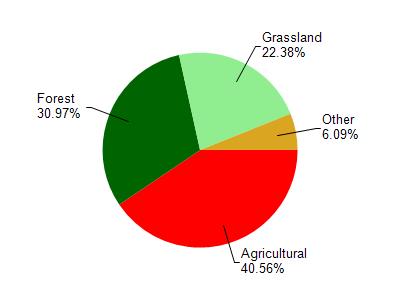Dunn, Pierce
Yes
No
No
Fish and Aquatic Life
Overview
Scenic Cady Creek has the potential to become a Class I trout stream for about seven miles of its
length if the impacts of polluted runoff are minimized. The stream is now classified as Class 11 trout
stream for 3.8 miles and Class 111 for 2.4 miles. Additionally, these portions of Cady Creek are
designated as an Exceptional Resource Water (ERW). The ERW designation prohibits any new
point source to discharge effluent that contains compounds in excess of background levels found in
Cady Creek, unless the discharge is needed to correct a public health problem.
The scenic beauty and water quality of this creek are threatened by streambank and hllside grazing,
runoff from barnyards and a limestone quarry operation. These land use practices threaten the
stream's aquatic habitat and water quality. An adequate food base, cover, and spawning habitat are
vital for a reproducing population of trout (Engel 1994).
Wisconsin Dairies Coop - Wilson (also known as Foremost Farms USA Cooperative) discharges
treated process wastewater to a dry run headwater of Cady Creek. The effluent seeps to
groundwater and does not reach the continuously flowing portion of Cady Creek. This discharge
condition has been termed a linear seepage cell. Federal regulations require a water quality standards
review of the portion of the headwater classified as a variance water for limited aquatic life. To
ensure compliance with groundwater quality standards, a private well survey and a sinkhole
inspection should be included in the next issuance of the WPDES permit (LaLiberte. See the
Groundwater Report in ths ~ l a n for more information about linear seepage cells.
Date 1996
Author Aquatic Biologist
General Condition
Cady Creek (miles 1.01-9.34) was assessed during the 2018 listing cycle; new biological (macroinvertebrate and fish Index of Biotic Integrity (IBI) scores) sample data were clearly below the 2018 WisCALM listing thresholds for the Fish and Aquatic Life use. This water was meeting this designated use and was not considered impaired.
Date 2017
Author Ashley Beranek
Condition
Wisconsin has over 84,000 miles of streams, 15,000 lakes and milllions of acres of wetlands. Assessing the condition of this vast amount of water is challenging. The state's water monitoring program uses a media-based, cross-program approach to analyze water condition. An updated monitoring strategy (2015-2020) is now available. Compliance with Clean Water Act fishable, swimmable standards are located in the Executive Summary of Water Condition in 2018. See also the 'monitoring and projects' tab.
Reports
Management Goals
Wisconsin's Water Quality Standards provide qualitative and quantitative goals for waters that are protective of Fishable, Swimmable conditions [Learn more]. Waters that do not meet water quality standards are considered impaired and restoration actions are planned and carried out until the water is once again fishable and swimmable
Management goals can include creation or implementation of a Total Maximum Daily Load analysis, a Nine Key Element Plan, or other restoration work, education and outreach and more. If specific recommendations exist for this water, they will be displayed below online.
Monitoring
Monitoring the condition of a river, stream, or lake includes gathering physical, chemical, biological, and habitat data. Comprehensive studies often gather all these parameters in great detail, while lighter assessment events will involve sampling physical, chemical and biological data such as macroinvertebrates. Aquatic macroinvertebrates and fish communities integrate watershed or catchment condition, providing great insight into overall ecosystem health. Chemical and habitat parameters tell researchers more about human induced problems including contaminated runoff, point source dischargers, or habitat issues that foster or limit the potential of aquatic communities to thrive in a given area. Wisconsin's Water Monitoring Strategy was recenty updated.
Grants and Management Projects
| Project Name (Click for Details) | Year Started |
|---|
|
|
Monitoring Projects
| WBIC | Official Waterbody Name | Station ID | Station Name | Earliest Fieldwork Date | Latest Fieldwork Date | View Station | View Data |
|---|
| 2058000 | Cady Creek | 483038 | Cady Creek - Nw1/4 Of Se1/4 Sec 25 | 4/23/1980 | 5/22/2001 | Map | Data |
| 2058000 | Cady Creek | 10015662 | Cady Creek 1- 50 Ft Upstream Of Cth P | 1/1/2015 | 1/1/2015 | Map | Data |
| 2058000 | Cady Creek | 10055781 | Cady Creek- 190m DS of CTH P | | | Map | Data |
| 2058000 | Cady Creek | 10009648 | Cady Creek 1- Cth P | 6/4/2009 | 10/27/2025 | Map | Data |
|

Watershed Characteristics
Cady Creek is located in the Eau Galle River watershed which is 267.88 mi². Land use in the watershed is primarily agricultural (40.60%), forest (31%) and a mix of grassland (22.40%) and other uses (6.10%). This watershed has 519.34 stream miles, 251.50 lake acres and 3,943.12 wetland acres.
Nonpoint Source Characteristics
This watershed is ranked High for runoff impacts on streams, Not Ranked for runoff impacts on lakes and High for runoff impacts on groundwater and therefore has an overall rank of High. This value can be used in ranking the watershed or individual waterbodies for grant funding under state and county programs.However, all waters are affected by diffuse pollutant sources regardless of initial water quality. Applications for specific runoff projects under state or county grant programs may be pursued. For more information, go to surface water program grants.